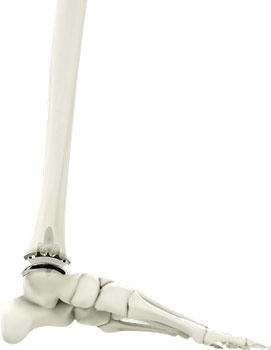Ankle Joint Replacement

What is Ankle Joint Replacement Surgery?
Ankle joint replacement, also known as total ankle arthroplasty, is a surgical procedure performed to relieve pain and immobility due to severe end stage arthritis that has not responded to non-surgical treatments. The goal of ankle joint replacement surgery is to eliminate your pain and increase the mobility of your ankle joint.
Ankle joint replacement is also recommended for elderly patients with a severe fracture from osteoporosis, or presence of a tumour in the ankle joint.
How is an Ankle Joint Replacement Performed?
Ankle joint replacement surgery is performed under general anaesthesia. Your surgeon makes an incision over the front of the ankle. The muscles are retracted and tendons and ligaments are moved away to expose the ankle joint. The damaged part of the tibia, fibula, and talus bone is then removed using special instruments, and the remaining part of the bones are reshaped to fit the new artificial joint or prosthesis. A bone graft is inserted between the tibia and fibula to create a fusion of the two bones and prevent loosening of the prosthesis. The prosthetics are kept in position by using special bone cement and instrumentation such as screws to support the artificial ankle.
At the end of the surgery, tendons and other structures are placed back in position covering the new joint and the wound is sutured closed and covered with a sterile dressing.
What is the Postoperative Care for an Ankle Joint Replacement?
Following ankle joint replacement, the patient may need to stay in the hospital for 2-3 days and will be advised on precautions for a successful recovery.
The treated ankle will be immobilized with the help of splints and a bulky dressing. Patients are advised not to put any weight on the ankle for at least 6 weeks and use crutches for walking. Usually, a drain tube is inserted into the joint during surgery for draining blood from the incision, and is removed within 1-2 days after the surgery. Swelling and discomfort can be managed by taking prescription pain medicines, applying ice packs, and by elevating the ankle above heart level while resting. You will be referred to physical therapy soon after surgery to regain range of motion of the new ankle. Sutures are removed after 10-15 days and you should take care that the incision is kept clean and dry. Patients should avoid smoking, alcohol consumption, and should eat a healthy diet for the best outcome.
What are the Risks and Complications of Ankle Joint Replacement?
As with any major surgery, there are potential risks involved. The possible complications associated with ankle joint replacement include infection, fracture of the tibia or fibula bone, dislocation of the ankle, damage to nerves or blood vessels, blood clots (DVT or Deep Venous Thrombosis), loosening of artificial components, failure to relieve pain, instability and stiffness.
Related Topics
- Bunion Surgery
- Ankle Sprain Surgical Intervention
- Cheilectomy
- Surgery for a Torn Achilles Tendon
- Ankle Ligament Reconstruction
- Ankle Joint Replacement
- Arthroscopic Ankle Surgery
- Ankle Fusion Surgery
- Foot and Ankle Trauma
- Foot and Ankle Conditioning Program
- Foot & Ankle Rehabilitation
- Minimally Invasive Bunion Surgery
- Minimally Invasive Achilles Repair
- Minimally Invasive Ankle Ligament Repair
- Lesser Toe Surgery
- Minimally Invasive Foot Surgery
- Big Toe Arthroscopy




